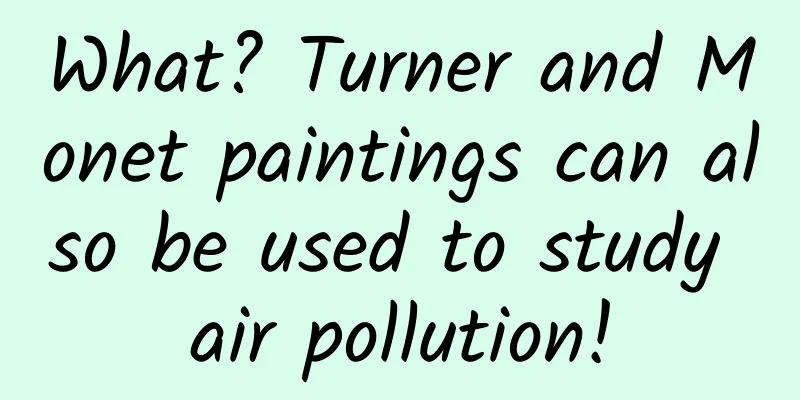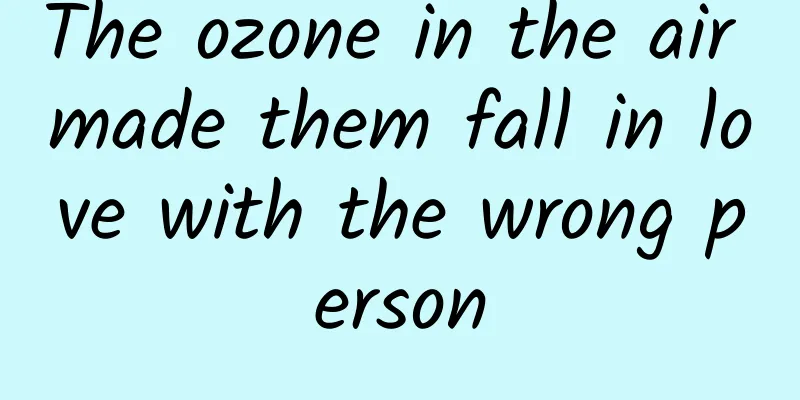What? Turner and Monet paintings can also be used to study air pollution!

|
Perhaps you will say: Shouldn’t air be colorless and invisible? So it doesn’t need to be depicted on the screen, so can we just leave it blank? However, this is not the case for painters. Before Impressionism, artists used air as the background of natural scenery, while Impressionist painters sometimes depicted air itself as the subject of their creations. Many masterpieces in the history of art have rich visual beauty, but in fact they are not as beautiful as they seem. Scientists have found that the poetic air texture in some paintings actually shows the air pollution conditions at that time. A paper in the journal Atmospheric Chemistry and Physics pointed out that the colors of sunsets painted by some famous artists, including Turner, can be used to estimate the level of air pollution at that time. Let's start with Turner's (James Mallord William Turner, 1775-1851) paintings. "Petworth Lake, Sunset and Deer" is a highly regarded work of Turner, the picture is full of dazzling sunset light, and the description of the sunset scenery is full of poetry and beauty. Turner's painting "The Lake, Petworth: Sunset, Fighting Bucks", circa 1829, at the Tate Gallery Unlike other well-known 19th century romantic paintings, Turner's paintings are soft, elegant, subtle, rich in layers, and closer to the feeling of Chinese ink painting. His colors are low-key and low in saturation, and the beauty of the sky presented in his unique way of expression has been "pierced through the poetic veil" by atmospheric science in recent years. Turner was born during the Industrial Revolution in Britain. According to the Tate Gallery, "Turner lived and created art at the height of the Industrial Revolution. Steam replaced sails and mechanical power replaced human labor. Many artists ignored these changes, but Turner took them seriously and incorporated them into his work." Turner's painting "Rain, Steam and Speed – The Great Western Railway", 1844, in the National Gallery, London The Tate Gallery pointed out that among his contemporaries, he was almost the only one who used industrial technology as a theme for artistic thinking, and his paintings naturally depicted the air pollution caused by the Industrial Revolution. Turner also painted the effects of a volcanic eruption. On April 10, 1815, Mount Tambora in Indonesia erupted in the largest eruption on Earth in the past 10,000 years, sending more than 36 cubic miles of rock powder into the atmosphere. The ash and gases ejected into the atmosphere formed an aerosol layer that surrounds the Earth. ● Photo of the crater formed by the eruption of Mount Tambora in Indonesia in April 1815 Source: ASSOCIATED PRESS The following year, average temperatures dropped, making 1816 the "year without a summer." A huge cloud of volcanic particles spread across the globe, blocking out sunlight and causing a three-year global cooling. The consequences of the extreme climate change that year were: not only did they give rise to countless oil paintings featuring blazing sun and blizzards, but they also produced bright red and orange sunsets across Europe for up to three years after the eruption. Painters of the time witnessed this scene, Turner being one of them, and the sunset he depicted in his painting became one of his most admired paintings. ● In his 1817 painting The Decline of the Carthaginian Empire, Turner used historical events to illustrate the hardships people experienced after a volcanic eruption, and the sky in the painting was also filled with tones affected by the eruption. Meteorological researchers have studied the paintings and traced the composition of the atmosphere and the extent of air pollution at the time. They found that the red-to-green ratio measured in sunset paintings by these masters of the time was closely correlated with the amount of volcanic aerosols in the atmosphere, regardless of the painting school to which the painters belonged. ●We can still see the "romantic moment" when the volcano erupts. Source/Unsplash Sunset is the most indicative time of the day because the sun shines on the earth at a very low angle. This makes most of the shorter green visible light be filtered out when the sunlight passes through the thicker atmosphere, while the longer red visible light is retained. Industrial pollutants and volcanic eruptions enhance this effect, making the filtering capacity of atmospheric particles stronger. The more serious the volcanic ash pollution in the sky, the more sunlight will be scattered, and it will look redder, thus forming a seemingly romantic sunset scene. As Turner himself said: "I paint what I see, not what I know." This may not be some self-modest words, but the artist's real experience! Shortly after Turner's death, another art movement that captured the subtle changes in light, shadow and atmosphere was born: Impressionism. In 1877, the French Impressionist master Monet created more than a dozen works with the Gare Saint-Lazare in Paris as the subject. Why are some paintings of the same place dirty and others colorful? It is not only the change of light and shadow, but also because Monet, as an Impressionist master, accurately captured and restored the air conditions at that time: that is because the impurities in the air scatter different colors under different weather conditions. This is not Monet's subjective creation or "personal style", but an objective presentation of his on-the-spot vision. In other words, what he shows us is the colorful air pollution scene described by Monet truthfully. Thanks to the sensitive perception and capture of light, shadow and color by art masters such as Turner and Monet, we can see the sky scene and the air conditions of a hundred years ago. If you are interested, in the following articles, we can go downstream along the long river of art and explore the Impressionist and Post-Impressionist periods, or trace back to the Baroque and Renaissance periods to see how artists respectively depicted the sky and air. Author: He Miao Edited by: Rourou Coordination: Niu Niu Design: Li Shizier, Hara Please indicate the source when reprinting |
Recommend
How to light? It's determined by your actions
Novel motion lighting control technology In today...
The Palace in the Sky is about to be completed - rushing from the Heavenly Palace to the edge of the solar system
On April 24, 2022, the Dongfanghong-1 satellite, ...
In Shanghai, people are already eating cacti from flower pots
Editor's note: Calendar Girl recently receive...
B-side product operations: a guide to avoiding pitfalls in demand management
The methods of demand collection, analysis, and i...
When eating hot pot in winter, correct these 5 bad habits quickly!
Winter hot pot Has a unique charm The steam is ri...
Can Tik Tok Assistant help you become popular? What's the use?
The Douyin Assistant is in the Douyin APP. The wa...
Solid info! Six aspects that a complete operation plan should include
Anyone who does operations will know that there a...
11 ways to attract private domain traffic on Douyin
Although Douyin is relatively more focused on pub...
Li Xiaoyue's Xiaohongshu full-level short video training camp, 30-day community training camp
Li Xiaoyue's Xiaohongshu full-level short vid...
You can see the road even when you are walking and playing with your phone. A magical APP that opens your mind
[[330277]] Many people like to play with their mo...
【Longdan Bright Silver Spear】Gun Brother Speculation: A Minimalist Market Viewing System
【Longdan Bright Silver Spear】Gun Ge Hot Money: A M...
APP UI design trends: moving for good design
Pleasing animation has become a must for an app, ...
Weekly Technology Awards|Driving into the Deep Blue to Explore the Unknown
In recent years, with the development of aerospac...
3 days, 0 budget, sales of 10,000 goods, all the activity methodology is here!
The article combines the author's actual expe...
Lessons on how to make money that ordinary people can implement
Course List Lesson 1-The relationship between bac...









